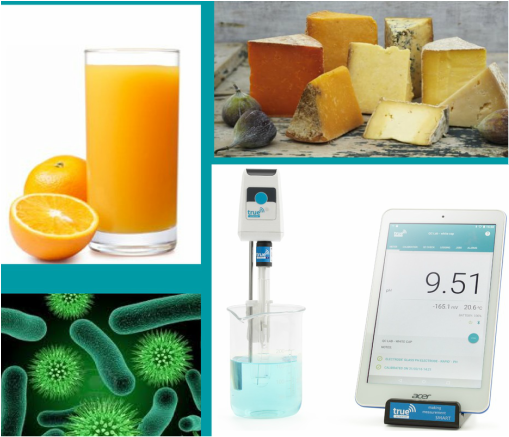The importance of pH in food products
18 August 2016
18 August 2016
The pH level of food products can affect a number of characteristics
While some of these relate to consumer preference, others have a direct impact on production quality and safety.
We’ve explored how pH affects 5 key areas; appearance, texture, taste, safety and production.

Before food touches our lips we judge it by appearance. The molecules in food which contribute to its colour can be changed by pH levels, thus changing the colour.
Green vegetables are a great example of this – for example canned green beans have a dull brown colour, compared to the fresh green found in fresh and frozen varieties. This is due to the pH – natural acids in the beans leach out into the water in the can, meaning the beans then sit in a mildly acidic solution which changes the colour.
Some foods even contain natural pH indicator pigments – red cabbage appears purple in neutral pH but turns green in alkaline conditions and red in acidic conditions!
Mouth-feel and texture of food is a major part of consumer perception of the product.
Cheese is formed by protein bonds being created, which is affected by pH. When rennet is added to milk which is more acidic, the final product is less chewy and springy. This means that getting the pH level right is vital in obtaining an end product which is as expected and within specification.
This reliance on pH extends into storage as well as production – when cheese is exposed to acidic conditions in storage the hardness and cohesiveness is found to decrease, and the cheese becomes crumbly.
pH affects the water holding capacity of foods, particularly meat products – tenderness is found to improve with acidic conditions.
Noodle dough is also affected by pH, with gluten interactions changed to create a firmer noodle in more alkaline conditions.
The familiar taste of your favourite food and drink is greatly affected by pH.
Wine is carefully monitored for changes in pH, and usually sits between 2.8 and 3.8 with more acidic pH giving a more dry product.
The effect can be seen in taste perception – increased pH levels were found to decrease the perceived intensity of sour tastes in this study.
In addition to making a product which falls within specification, production time and yield are also affected by pH in certain processes.
The pH of milk during the renneting stage of cheese production changes the amount of fat lost to the whey, thus changing the overall yield of a batch.
Fermentation and ageing of wine is influenced by pH – at the wrong pH level bacteria can attack wine causing it to spoil.
The pH of the mash in beer production can really change the final product – lower pH is favoured for improving enzyme activity and creating more sugars, better yeast health during fermentation, bacterial growth inhibition, better hop extraction and even better clarity with a less hazy appearance. This means that getting the pH right during this early stage of production is important to get the whole brew right.
Milk pH changes the end texture of yogurt, with a pH of 6.7 creating the best gel stiffness. This illustrates again how accurately measuring pH at early stages of production can influence the entire batch.
In preserved and fresh foods, the pH can greatly influence bacterial growth and thus overall food safety and shelf life.
Sauces like mayonnaise are often made slightly acidic by lemon juice or vinegar, which prolongs their shelf life.
In preserved products, ensuring the right level of acidity prevents bacterial growth and the formation of toxins which can cause botulism. Heat is still used as an additional preventitive measure in conjunction with pH to give the best guard against bacterial growth.
Getting pH right from raw ingredients through to final product and even storage will ensure that foods fall within specifications in taste, texture and safety.
Make sure that the measurements you take are accurate by calibrating regularly and using a suitable electrode for the task.
Keep records accurately so that issues can be identified and final product as well as raw ingredient batches can be fully traced.
Consider where in your process pH level constitutes a HACCP check, and ensure these readings particularly have full tractability.
The TRUEscience system aims to help food producers with all these steps;
Contact us here to find out more about how TRUEscience can help you to manage pH readings during production.